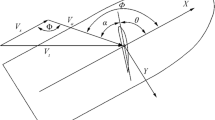Abstract
The steady sailing performance of a sail-assisted bulk carrier is investigated utilising towing-tank derived hydrodynamic derivatives and wind tunnel measured aerodynamic properties of the sails and the ship. The aerodynamic characteristics investigated include the ship hull at the fully-loaded draught, the sail–sail interaction effects for two sets of four identical hybrid-sails, and the sail–hull interaction effects for the same two sets of identical sails in the presence of the selected bulk carrier hull-form. This is in addition to lift–drag measurements of single isolated sails of each shape. The form of the two sets of soft sails was rectangular and triangular. This paper is concerned with assessing the benefits of a sail-assisted ship operation, and hence a steady-state rather than complete time-domain integrations of the governing equations are reported. The results of the completed analysis suggest that the benefits of the derived sail generated driving force are greater than the overhead of equipping the ship with a selected system of hybrid-sails. Sail-assisted ships could represent an important contribution to an improving global environment by reducing the demands for a driving force through the propeller.
Similar content being viewed by others
References
K Kijima T Katsuno Y Nakiri et al. (1990) ArticleTitleOn the manoeuvring performance of a ship with the parameter of loading condition J Soc Nav Archit Jpn 168 141–148
H Fujii T Tsuda (1961) ArticleTitleExperimental research on rudder performance. 2 (in Japanese) J Soc Nav Archit Jpn 110 31
Y Yoshimura Y Tanabe I Ohsugi et al. (1990) ArticleTitleOn the prediction of the sailing performance for a large sail training ship (in Japanese) J Jpn Inst Navig 84 19–27
Fujiwara T, Hirata K, Ueno M, et al (2003) On aerodynamic characteristics of a hybrid-sail with square soft sail. In: Proceedings of the International Society of Offshore and Polar Engineering, ISOPE2003, Hawaii, pp 326–333
Fujiwara T, Hirata K, Ueno M, et al (2003) On development of high performance sails for an oceangoing sailing ship. In: Proceedings of the International Conference on Marine Simulation and Ship Manoeuvrability, MARSIM’03, Kanazawa, pp RC-23-1-9
Ishihara M, Watanabe T, Shimizu K, et al (1980) Prospect of sail-equipped motorship as assessed from experimental ship “Daioh”. In: Proceedings of the Shipboard Energy Conservation Symposium, Society of Naval Architects and Marine Engineers, pp 181–198
Matsumoto N, Inoue M, Sudo M (1982) Operating performance of a sail equipped tanker in wave and wind. In: 2nd International Conference on Stability of Ships and Ocean Vehicles, STAB ‘82, Tokyo, pp 451–464
Minami Y, Nimura T, Fujiwara T, et al (2003) Investigation into underwater fin arrangement effect on steady sailing characteristics of a sail assisted ship. In: Proceedings of the International Society of Offshore and Polar Engineering, ISOPE2003, Hawaii, pp 318–325
Minami Y, Nimura T, Fujiwara T, et al (2003) Investigation into underwater fin arrangement effect on steady sailing characteristics of a sail assisted ship. In: Proceedings of the International Conference on Marine Simulation and Ship Manoeuvrability, MARSIM’03, Kanazawa, pp RB-8-1-8
Fujiwara T, Kitamura F, Ueno M, et al (2004) Hybrid-sail–hull and sail-sail interaction effects for an ocean-going sailing ship. In: Proceedings of the International Society of Offshore and Polar Engineering, ISOPE2004, Toulon, pp 351–358
T Fujiwara GE Hearn F Kitamura et al. (2005) ArticleTitleSail–sail and sail–hull interaction effects of hybrid-sail assisted bulk carrier J Mar Sci Technol 10 82–95 Occurrence Handle10.1007/s00773-005-0191-4
Hirano M, Takashina J (1980) A calculation of ship turning motion taking coupling effect due to heel into consideration. J West Jpn Soc Nav Archit 59
Kansai Shipbuilding Design Handbook (1983) Kansai Society of Naval Architects, Japan, p 465
K Kijima Y Nakiri (1999) ArticleTitleApproximate expression for hydrodynamic derivatives of ship manoeuvring motion taking into account the effect of stern shape J West Jpn Soc Nav Archit 98 67–77
Watanabe I, Tomita H, Tanizawa K (1992) Statistical diagrams on the wind and waves on the north Pacific Ocean (1974–1988) (in Japanese). Report of NMRI 14 (http://www.nmri.go.jp/wavedb/wavedb.html)
Woud HK, Stapersma D (2002) Design of propulsion and electric power generation systems. IMarEST, p 478
Author information
Authors and Affiliations
Corresponding author
About this article
Cite this article
Fujiwara, T., Hearn, G., Kitamura, F. et al. Steady sailing performance of a hybrid-sail assisted bulk carrier. J Mar Sci Technol 10, 131–146 (2005). https://doi.org/10.1007/s00773-004-0189-3
Received:
Accepted:
Issue Date:
DOI: https://doi.org/10.1007/s00773-004-0189-3




